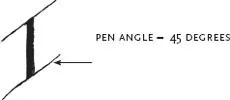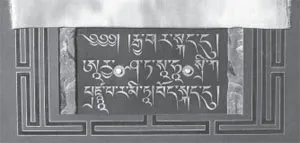
- 104 pages
- English
- ePUB (mobile friendly)
- Available on iOS & Android
eBook - ePub
About this book
In Tibetan Calligraphy, Sanje Elliott shows us how to capture the elegance and grace of Tibetan calligraphy without prior knowledge of either Tibetan language or calligraphy. This beautiful book includes many prayers, mantras, and seed syllables to copy and study. Perfect for practitioners, artists, and anyone interested in the Tibetan language.
Frequently asked questions
Yes, you can cancel anytime from the Subscription tab in your account settings on the Perlego website. Your subscription will stay active until the end of your current billing period. Learn how to cancel your subscription.
At the moment all of our mobile-responsive ePub books are available to download via the app. Most of our PDFs are also available to download and we're working on making the final remaining ones downloadable now. Learn more here.
Perlego offers two plans: Essential and Complete
- Essential is ideal for learners and professionals who enjoy exploring a wide range of subjects. Access the Essential Library with 800,000+ trusted titles and best-sellers across business, personal growth, and the humanities. Includes unlimited reading time and Standard Read Aloud voice.
- Complete: Perfect for advanced learners and researchers needing full, unrestricted access. Unlock 1.4M+ books across hundreds of subjects, including academic and specialized titles. The Complete Plan also includes advanced features like Premium Read Aloud and Research Assistant.
We are an online textbook subscription service, where you can get access to an entire online library for less than the price of a single book per month. With over 1 million books across 1000+ topics, we’ve got you covered! Learn more here.
Look out for the read-aloud symbol on your next book to see if you can listen to it. The read-aloud tool reads text aloud for you, highlighting the text as it is being read. You can pause it, speed it up and slow it down. Learn more here.
Yes! You can use the Perlego app on both iOS or Android devices to read anytime, anywhere — even offline. Perfect for commutes or when you’re on the go.
Please note we cannot support devices running on iOS 13 and Android 7 or earlier. Learn more about using the app.
Please note we cannot support devices running on iOS 13 and Android 7 or earlier. Learn more about using the app.
Yes, you can access Tibetan Calligraphy by Sanje Elliott in PDF and/or ePUB format, as well as other popular books in Art & Art Techniques. We have over one million books available in our catalogue for you to explore.
Information
1. GETTING STARTED

Gather your materials from the list provided below. I recommend that you start with real ink and pens right from the beginning. Perhaps later you can work with flat-edge felt-tipped pens or other writing tools, but sometimes these are too easy to help with deeply learning the forms; we need to feel the liquid ink on the paper.
After you have gathered your materials, find a quiet place to practice.
Make friends with your pen.
Please don’t forget to breathe; first inhale and then, as you exhale, feel the ink flowing out the pen onto the paper. This is very important, because if you hold your breath and tense your body, you will not achieve a good result.
Practice all the introductory pen strokes on pages 11–14, giving special effort to the ones that require a twist, or rotation, of the pen in your fingers. Practice first the vertical twist and then the horizontal twist. The accompanying photos on those pages should help you to see how the pen is manipulated for these strokes. When you have become successful with the introductory strokes, start the alphabet and practice each letter until you have achieved a good facsimile of the model in the book.
Spend some time every day practicing. Don’t just dip in every two weeks or so. You need to practice regularly and for some time to develop ease and confidence in your letters.
After you have completed the alphabet and also mastered the stacked letters, you may want to try some of the mantras in the back of this book. It is very important to do the exercises in this book in the proper order; leaping ahead will only cause frustration, confusion, and obstacles.
CONTEMPLATIVE PRACTICE
Along with meditation, mantra chanting, and thangka painting, practicing Tibetan calligraphy can be considered a contemplative Dharma practice. When it is viewed in this way, it is very good to open the practice session with the refuge and bodhichitta prayers, then, at the end of the practice, you can dedicate the merit to all beings, so that the virtue of the practice will be shared by all. If your teacher has given you a particular form of the dedication prayer you can use that, or you can use the one on page 73.
Practicing like this, mindfully and keeping aware of the breath as one writes the letters, can be a source of inspiration to the student of calligraphy and can create some benefit for oneself and also for others.
MATERIALS
► pen holder (the wooden handle into which you insert the nib and which you grip while drawing or writing)
► pen nibs: Tape or Brause 2 ½ mm nib with reservoir, or Speedball C-2
► ink: Higgins Eternal (this is really the best choice for beginners as it is easy to wash out!)
► eye dropper to load ink into pen reservoir
► paper: pad of 11′ × 17′ gridded paper, 8 grids per inch
► fountain pen: Schaeffer’s calligraphy fountain pen, medium nib
Optional Materials
► slanted easel (to allow writing at a better angle for better vision and straighter back)
► T square (if you’re writing on nongridded paper, you can use this to create lines on the paper)
► drawing pencil, #2H is preferable
► vermillion Japanese liquid ink or your choice of gouache (opaque watercolor)
► larger nibs: Hiro #10 or #15
If your local art shop does not have the above items, most of them can be easily ordered online.
GLOSSARY OF IMPORTANT TERMS
Lantsa
The decorative letters derived from the Sanskrit ranjana script in the eleventh century. It is used in jewelry, sculpture, prayer wheels, and temple decorations. While we won’t be learning lantsa in this book, it nonetheless is a beautiful alphabet worth exploring.

OM MANI PADME HUM mantra in lantsa carved in wood.
Pen Angle
The pen angle is the angle at which the pen is addressed to the paper; for our purposes, it should be forty-five degrees. Many alphabets, including the roman letters, are written with a forty-five or near-forty-five-degree angle. This is made possible by the use of a flat-edged pen, or a reed or bamboo pen such as those used by Tibetans. The benefit of writing at such a pen slant is the inherent beauty of the contrasting thick and thin elements of the characters, giving it a distinctive, calligraphic look.

Pen Scale
The ratio of the height of the letter to the width of the pen nib. For example the uchen alphabet letters are seven pen widths high, assuming you are using the nibs mentioned in the section on materials. Some letter combinations may become taller than seven pen widths, especially when letters are stacked on top of each other, or combined with vowel markers.

Twist
The pen stroke used to create a properly tapering vertical stroke: thick at the top and diminishing to a hairline at the bottom. This is done by twisting or rotating the pen counterclockwise as it is moving down the page. To learn to do this, practice rolling the pen counterclockwise between the thumb and the middle finger. Notice how the thumb moves down toward the nib as the pen rotates and the tip of the pen is rotated to its vertical edge.
Uchen
The uchen script is the most prevalent form of Tibetan script, as it is the standard for printing. Its earliest use was in the transcribing of Buddhist scriptures from Sanskrit into Tibetan. The word literally means “with a head.” It is comparable to the serif faces of roman type used for printing in the West and is the subject of this book.

Prajnaparamita text written in uchen.
Umé
Umé is a sort of sans-serif Tibetan script that has evolved many forms over time, from very formal and elegant scripts to Tibetan shorthand. It literally means “headless” because it does not include the header line employed by the uchen script; it also uses vertical lines rather than dots to separate sy...
Table of contents
- Cover
- Title
- Dedication
- Table of Contents
- Foreword by Sarah Harding
- Introduction
- 1. Getting Started
- 2. The Fundamental Pen Strokes
- 3. The Alphabet
- 4. Vowel Markers
- 5. Stacked Letters
- 6. The Six Reversed Letters
- 7. Punctuation
- 8. Numerals
- 9. Seed Syllables
- 10. Mantras
- 11. Prayers
- Afterword
- Additional Resources
- Acknowledgments
- About the Author
- About Wisdom Publications
- Copyright